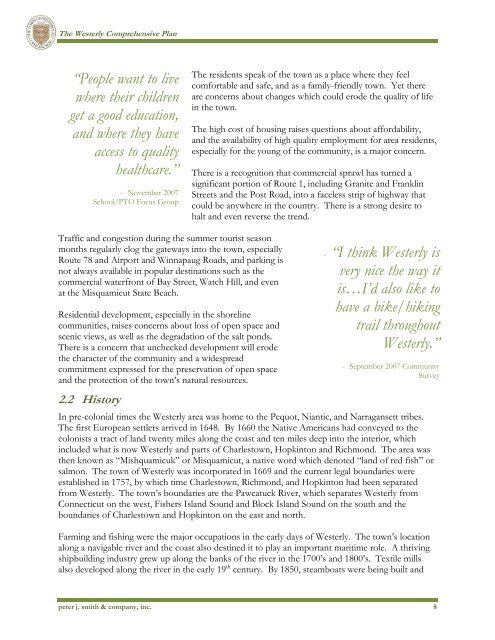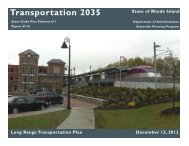Westerly - State of Rhode Island: Division of Planning
Westerly - State of Rhode Island: Division of Planning
Westerly - State of Rhode Island: Division of Planning
Create successful ePaper yourself
Turn your PDF publications into a flip-book with our unique Google optimized e-Paper software.
The <strong>Westerly</strong> Comprehensive Plan“People want to livewhere their childrenget a good education,and where they haveaccess to qualityhealthcare.”- November 2007School/PTO Focus GroupThe residents speak <strong>of</strong> the town as a place where they feelcomfortable and safe, and as a family-friendly town. Yet thereare concerns about changes which could erode the quality <strong>of</strong> lifein the town.The high cost <strong>of</strong> housing raises questions about affordability,and the availability <strong>of</strong> high quality employment for area residents,especially for the young <strong>of</strong> the community, is a major concern.There is a recognition that commercial sprawl has turned asignificant portion <strong>of</strong> Route 1, including Granite and FranklinStreets and the Post Road, into a faceless strip <strong>of</strong> highway thatcould be anywhere in the country. There is a strong desire tohalt and even reverse the trend.Traffic and congestion during the summer tourist seasonmonths regularly clog the gateways into the town, especiallyRoute 78 and Airport and Winnapaug Roads, and parking isnot always available in popular destinations such as thecommercial waterfront <strong>of</strong> Bay Street, Watch Hill, and evenat the Misquamicut <strong>State</strong> Beach.Residential development, especially in the shorelinecommunities, raises concerns about loss <strong>of</strong> open space andscenic views, as well as the degradation <strong>of</strong> the salt ponds.There is a concern that unchecked development will erodethe character <strong>of</strong> the community and a widespreadcommitment expressed for the preservation <strong>of</strong> open spaceand the protection <strong>of</strong> the town’s natural resources.2.2 History- “I think <strong>Westerly</strong> isvery nice the way itis…I’d also like tohave a bike/hikingtrail throughout<strong>Westerly</strong>.”- September 2007 CommunitySurveyIn pre-colonial times the <strong>Westerly</strong> area was home to the Pequot, Niantic, and Narragansett tribes.The first European settlers arrived in 1648. By 1660 the Native Americans had conveyed to thecolonists a tract <strong>of</strong> land twenty miles along the coast and ten miles deep into the interior, whichincluded what is now <strong>Westerly</strong> and parts <strong>of</strong> Charlestown, Hopkinton and Richmond. The area wasthen known as “Mishquamicuk” or Misquamicut, a native word which denoted “land <strong>of</strong> red fish” orsalmon. The town <strong>of</strong> <strong>Westerly</strong> was incorporated in 1669 and the current legal boundaries wereestablished in 1757, by which time Charlestown, Richmond, and Hopkinton had been separatedfrom <strong>Westerly</strong>. The town’s boundaries are the Pawcatuck River, which separates <strong>Westerly</strong> fromConnecticut on the west, Fishers <strong>Island</strong> Sound and Block <strong>Island</strong> Sound on the south and theboundaries <strong>of</strong> Charlestown and Hopkinton on the east and north.Farming and fishing were the major occupations in the early days <strong>of</strong> <strong>Westerly</strong>. The town’s locationalong a navigable river and the coast also destined it to play an important maritime role. A thrivingshipbuilding industry grew up along the banks <strong>of</strong> the river in the 1700’s and 1800’s. Textile millsalso developed along the river in the early 19 th century. By 1850, steamboats were being built andpeter j. smith & company, inc. 8
















